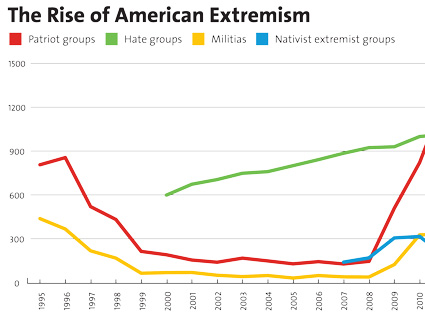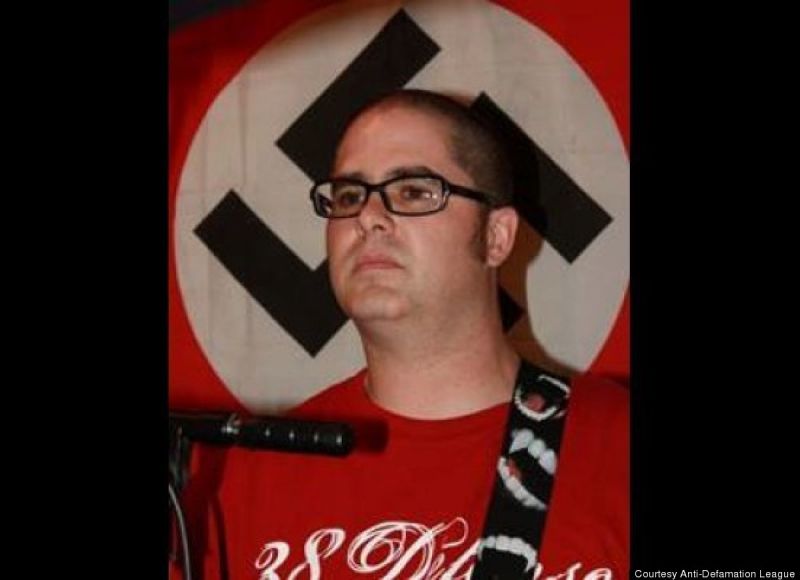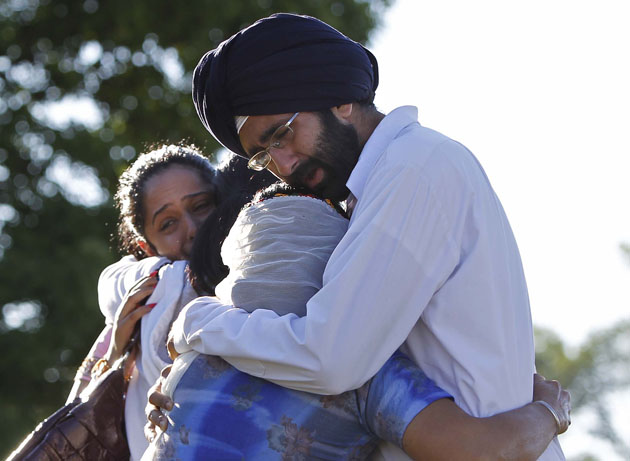
Candlelight vigil for victims of the Sikh temple shooting.

This past Monday, when FBI Special Agent Teresa Carlson briefed reporters on the shooting rampage at a Sikh temple in Wisconsin that left six people dead, she said law enforcement had no prior indication that the shooter, Wade Michael Page, had been dangerous. “As far as I know, no law enforcement agency had any reason to believe that he was planning or plotting or capable of such violence,” she said.
The Southern Poverty Law Center, which maintains an archive of published material from white supremacists and other hate groups, says that Page, who played in white supremacist rock bands and was involved with a skinhead group called the Hammerskins, began showing up in their database as early as 10 years ago. “There are hundreds of people involved in neo-Nazi groups and skinhead bands, maybe thousands, who say and write the kind of violent things that this guy did,” notes Heidi Beirich, director of the SPLC’s Intelligence Project. “The ability to figure out who is going to actually do [violence] is not easy. This stuff is protected [speech] and most people don’t commit violence.”
It’s impossible to know for sure whether law enforcement could have detected Page’s plot in advance. But former Department of Homeland Security analyst Daryl Johnson thinks DHS may have bypassed the opportunity. “If he was on Stormfront or any of these other forums that cater to white supremacists and was talking about violent things, we might have been able to pick up on that and refer it over to the FBI,” says Johnson. Page also met several of the criteria, such as military training, that Johnson says appeal to recruiters for extreme right-wing groups.
DHS used to monitor those forums. Working under DHS Secretary Janet Napolitano, Johnson headed a team of analysts devoted to ferreting out domestic terrorism. Several of their referrals, he says, led to criminal cases. But conservatives went ballistic over his team’s 2009 report on the threat posed by right-wing extremists.
Concern that monitoring of “extremists” could result in spying on Americans engaged in lawful political activity is legitimate, since it’s certainly happened before. And while Johnson’s report was meant to focus on violent right-wing extremist groups—not your average Republican voter—conservative commentators still felt persecuted. They claimed Napolitano and President Barack Obama were targeting mainstream conservatives and Tea Party activists. Hot Air blogger Ed Morrisey wrote that the report was an attempt to “smear half of the country or more as kooks for criticizing the government’s handling of the economy.” Conservative pundit Michelle Malkin called it “a sweeping indictment of conservatives.”
As detailed by Spencer Ackerman in Wired, the political backlash prompted Homeland Security to shut down Johnson’s team and curtail its “passive monitoring” of right-wing extremists—e.g., surveillance of publicly available information such as white supremacist web forums. Nowadays, Johnson says, the department’s Office of Intelligence and Analysis has just one analyst who focuses on domestic terrorism by non-Muslims. (DHS did not respond to my request for comment.)
“There’s one analyst there despite all the attacks, the criticism, and all the issues that were raised when I went public last year,” says Johnson, who first spoke to the Washington Post about the shake-up last June. “Why hasn’t Napolitano been responsible for reconstituting the domestic terrorism effort in her department?”
The remaining analyst, Johnson adds, has his writing scrutinized for “politically sensitive” content as the DHS seeks to preempt any further backlash.
While Johnson acknowledged to Wired that the characterization of the threat in his report was “imprecise,” he still feels that DHS overreacted. “They caved in, and not only did they cave in, but they got rid of the entire unit for dealing with these kinds of issues.”
Chart: Mother Jones
In recent years, meanwhile, America has seen numerous instances of right-wing terrorism, from the lone gunman who attacked the Holocaust Museum to an attempt to plant an improvised explosive device at a Martin Luther King Day parade in Spokane, Washington. An analysis by Peter Bergen of CNN counted eight terrorist attacks carried out by extremist right-wingers since 9/11, compared to four by al-Qaeda inspired or affiliated terrorists. The latter resulted in more deaths, however, largely because 13 people were killed in November 2009 when Maj. Nidal Malik Hasan opened fire on his Army comrades at Texas’ Ft. Hood.
Mike German, a former FBI agent who did undercover work infiltrating extremist groups including neo-Nazis and militia groups and is now senior policy counsel for the ACLU, told me that more government surveillance isn’t the solution, and that it’s a mistake to think there’s a technological silver bullet that can flawlessly identify threats before they can be carried out. Most people with extreme views, German says, hold horrible (but constitutionally protected) beliefs they never act on.
“Whether you look at the Nidal Hasan case, or the [underwear bomber] case, it’s not a lack of information,” German says. “In fact, they’re pulling in so much information that they can’t distinguish between someone with a bad attitude and someone who is actually a threat…What they need to do is focus resources on people who are actual threats based on a factual basis that brings reasonable suspicion that someone is actually doing harm.”
Johnson insists that more can be done, but that for political reasons neither Congress nor the administration are inclined to act. “Why hasn’t Congress held any hearings, particularly the Homeland Security committee, on the radicalization of white supremacists? We’ve had numerous things happen in the past three years, and yet [GOP Rep.] Peter King is still preoccupied with the Muslim extremist threat,” he says. “What is it going to take for Congress to have a hearing on white supremacist radicalization and developing a strategy for how to counter it?”
The answer to stopping future events like the Sikh temple shooting isn’t to transfer the panic reserved for al Qaeda-linked plots to those involving domestic radicals. Yet in the latter cases, unlike the Ft. Hood shooting, there hasn’t been much of a response from politicians other than expressions of grief and sorrow. When a white supremacist goes on a killing spree, it’s just another tragic inevitable consequence of living in an imperfect world. When a Muslim does the same thing, we actually expect the government to do something about it.
Charts by Jaeah Lee and Maya Dusenbery














